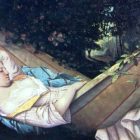“Beruffled Little Wet Apron” or “Vast and Prodigious Cadence of Water”?: Bicycling at Niagara Falls
As a child in the Midwest, I was shocked to find out that my parents hadn’t honeymooned at Niagara Falls, which I’d thought was sort of a requirement. It turned out that they’d instead spent three days in Hannibal, Missouri, Mark Twain country. Niagara Falls seemed even more romantic by contrast, more mythical.
Mark Twain himself was initially not that impressed when he visited Niagara Falls. He wrote,
When I first approached [the Falls] it was with my face lifted toward the sky, for I thought I was going to see an Atlantic ocean pouring down thence over cloud-vexed Himalayan heights, a sea-green wall of water sixty miles front and six miles high, and so, when the toy reality came suddenly into view—that beruffled little wet apron hanging out to dry—the shock was too much for me, and I fell with a dull thud.”
I have now lived near Niagara Falls for almost fifteen years, far from my Midwestern home, and I’ve always found it mesmerizing to stand by the guard rails directly above the Horseshoe Falls, above all of that crashing power, water racing, then plunging, mist rising above it. While my wonder is partly about the sight itself, its layers of history and the words of others, even Twain’s disappointed ones, contribute to it.
Father Hennepin, one of the first white explorers to stumble across the Falls, called them “this vast and prodigious cadence of water.” The Duke of Argyle was enthralled by “the leaping and rushing of the water” and Anthony Trollope compared the “voice of the cataract” to “the expression of your own heart.” Being there, particularly my first few years of living in the area, far from home, feeling fragmented, something about the Falls made me feel as if a thousand far-flung pieces of myself were stitching back together. The past couldn’t go on feeling like a chain of broken links in the face of those rapids flowing from one swell to another, rushing toward something momentous, toward the inescapable free fall of real life.
When my daughter was eight, we spent a weekend bicycling in Niagara Falls State Park, crossing the pedestrian bridge to Goat Island, where it’s a short path past the Bridal Falls, the American and Horseshoe Falls, and the Horseshoe Rapids. Black and gray seagulls landed in front of us. They fanned their tails and took flight again. Pink and white blossoms dotted the borders of the path, and the damp air smelled fishy. I whipped along, the wind in my face, water pulsing and pounding alongside us as I veered around my daughter, who pedaled madly to catch up.
She zipped past me, over the bridge to Three Sisters Islands, when I paused to read the sign. Asenath, Angeline, and Celinda Eliza Whitney had once crossed ice to picnic on these islands. It was 1816, known as “the year without summer,” when a volcanic eruption had led to a long, cold season with minimal sunlight.
I’d lost sight of my daughter. I hastened over the First Sister, another bridge, the Second Sister. Dreamily, I thought about how, 153 years before, Margaret Fuller had also crossed to these islands, and written of the Third Sister, “When I stood upon this frail support, and saw a quarter of a mile of rumbling, rushing rapids, and heard their everlasting roar, my emotion overpowered me.”
I got a little thrill, imagining all the people who’d walked this ground before me, feeling the same restlessness and longing and wonder, the same eternal power. “It is with roses and locomotives (not to mention acrobats Spring electricity Coney Island the 4th of July the eyes of mice and Niagara Falls) that my ‘poems’ are competing,” e.e. cummings wrote. “They are also competing with each other, with elephants, and with El Greco.”
Suddenly, my daughter started yelling for me. She had wrecked her bike on rocks several feet of stony ground from the rapids, the same island off of which a little girl drowns in Lauren Belfer’s City of Light.
Fortunately, our fate was much more pleasant. A passing stranger helped us reattach her chain, and we were off again, spinning round and round the island while the words of writers lapped and flowed as peacefully and powerfully as the rapids that hurled themselves along their ancient path.
Even Mark Twain would eventually come around to the Falls’ wonder—sort of—writing,
Yet slowly, surely, steadily, in the course of my fifteen visits, the proportions adjusted themselves to the facts, and I came at last to realize that a waterfall a hundred and sixty-five feet high and a quarter of a mile wide was an impressive thing. It was not a dipperful to my vanished great vision, but it would answer.”




